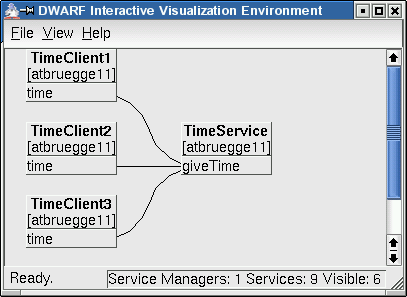Up to DwarfMiddlewareTutorial, forward to DwarfMiddlewareTutorialLesson6, back to DwarfMiddlewareTutorialLesson4
This lesson introduces the  The service manager shows the multiple instances of the time clients starting up, called
The service manager shows the multiple instances of the time clients starting up, called
Up to DwarfMiddlewareTutorial, forward to DwarfMiddlewareTutorialLesson6, back to DwarfMiddlewareTutorialLesson4 -- AsaMacWilliams - 17 Jul 2003
Lesson 5: Multiple services using templates
In this lesson, you will learn how to create multiple instances of the same service.Reconfigure the time client and server
Use the installed binariesTimeService and TimeClient of DwarfMiddlewareTutorialLesson2, and start up the service manager.
Run make all in (top build directory)/src/tutorials/middleware/lesson5. This will install two new service descriptions:
| TimeService | TimeClient |
|---|---|
<service name="TimeService" isTemplate="false">
<ability name="giveTime" type="TimeOfDay">
<connector protocol="ObjrefExporter"/>
</ability>
</service>
|
<service name="TimeClient" isTemplate="true">
<need name="time" type="TimeOfDay">
<connector protocol="ObjrefImporter"/>
</need>
</service>
|
isTemplate attribute. By default, it is false, and only one instance of the service may exist on the host at any time. This makes sense for services that encapsulate physical resources, such as trackers or displays. When it is true, there may be any number of instances of this service running.
In this example, only the client is a template; the TimeService will behave as before.
Try it out
In one terminal, runTimeService. In three other terminals, run TimeClient. All three clients will be able to run and connect to the TimeService, showing this DIVE image:
 The service manager shows the multiple instances of the time clients starting up, called
The service manager shows the multiple instances of the time clients starting up, called TimeClient1 to TimeClient3. Note that an additional service description, TimeClient4, is kept in reserve, so that it can prepare to set up connections even before the service itself is started.
19:19:44.999 3348 2 servicemgr.cpp 171 ServiceManager_i 1/ 1 services: newServiceDescription(TimeClient) 19:19:45.017 3348 2 servicemgr.cpp 171 ServiceManager_i 2/ 1 services: newServiceDescription(TimeService) 19:19:45.033 3351 2 servicemgr.cpp 191 ServiceManager_i 3/ 1 services: addClonedServiceDescription(TimeClient1) 19:19:45.042 3348 2 servicemgr.cpp 171 ServiceManager_i 4/ 1 services: newServiceDescription(DIVE) 19:19:45.096 3348 2 servicemgr.cpp 171 ServiceManager_i 5/ 1 services: newServiceDescription(ServiceReporter) 19:20:02.946 3389 2 servicemgr.cpp 141 ServiceManager_i 6/ 1 services: registerService(TimeService) 19:20:06.936 3404 2 servicemgr.cpp 141 ServiceManager_i 6/ 2 services: registerService(TimeClient) 19:20:06.948 3351 2 servicemgr.cpp 191 ServiceManager_i 6/ 2 services: addClonedServiceDescription(TimeClient2) 19:20:07.067 3411 2 servicemgr.cpp 141 ServiceManager_i 7/ 3 services: registerService(TimeClient) 19:20:07.083 3351 2 servicemgr.cpp 191 ServiceManager_i 7/ 3 services: addClonedServiceDescription(TimeClient3) 19:20:07.087 3413 2 servicemgr.cpp 141 ServiceManager_i 8/ 4 services: registerService(TimeClient) 19:20:07.111 3351 2 servicemgr.cpp 191 ServiceManager_i 8/ 4 services: addClonedServiceDescription(TimeClient4)In another terminal, run
TimeService again, while one instance is already running. Since isTemplate=false for TimeService, an error message occurs:
********************************************** * Detected run-time error in thread 4966 * 19:48:17.721 4966 0 activeservicedesc.cp 450 ActiveServiceDescription_i TimeService,Started: service alredy registered 19:48:17.713 4966 5 activeservicedesc.cp 435 ActiveServiceDescription_i TimeService,Started: registerService 19:48:17.712 4966 2 servicemgr.cpp 141 ServiceManager_i 9/ 5 services: registerService(TimeService) **********************************************Now, set
isTemplate=true for the TimeService. This will allow you to start more than one TimeService at a time. However, the TimeClients will still only connect to one TimeService each - in fact, this will usually be the first one.
Exercise 5.1 How many TimeClients can you start until the machine you are using becomes unusable?
Up to DwarfMiddlewareTutorial, forward to DwarfMiddlewareTutorialLesson6, back to DwarfMiddlewareTutorialLesson4 -- AsaMacWilliams - 17 Jul 2003
